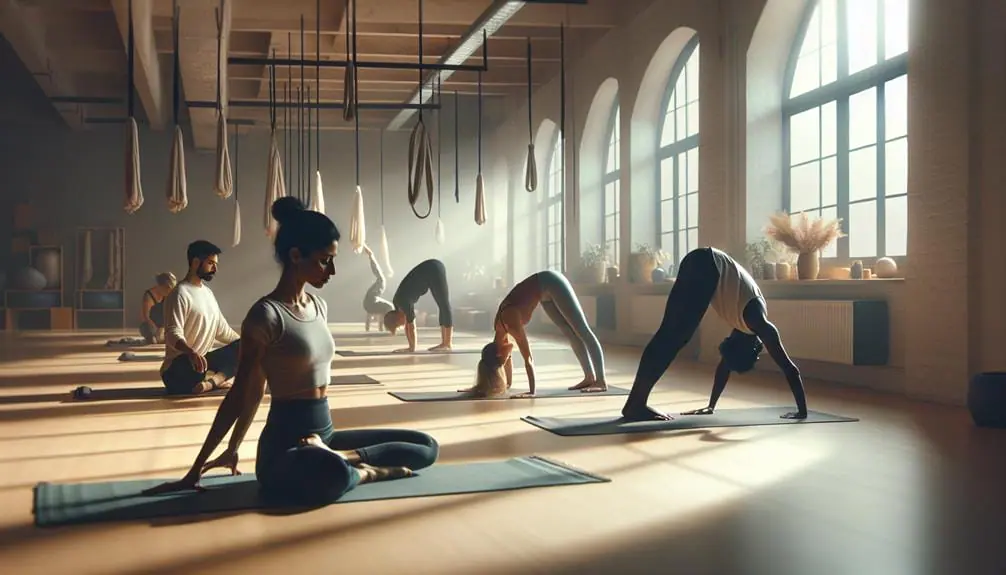Low-impact exercises are perfect for enhancing fitness at any level without stressing your joints. Walking boosts cardiovascular health and improves mood. Swimming offers a total body workout, engaging muscles and improving endurance. Cycling enhances cardiovascular health and leg strength, burning up to 1,000 calories an hour. Yoga and Pilates build core strength, flexibility, and balance, focusing on controlled movements. Circuit training combines cardio and strength exercises for a full-body workout, promoting fat loss and muscle endurance. You'll find that these exercises provide significant health benefits while keeping your joints happy, and there's much more to explore in each activity.
Key Takeaways
- Walking improves cardiovascular health and mood, and is a convenient and effective way to stay fit.
- Swimming provides a total body workout, burns calories, and is perfect for those with arthritis or recovering from injuries.
- Cycling strengthens leg muscles, improves endurance, and burns significant calories while being gentle on joints.
- Yoga and Pilates enhance core strength, flexibility, and balance, suitable for all fitness levels.
- Circuit training combines strength and cardiovascular exercises, boosting metabolism and muscle endurance without putting stress on joints.
Benefits of Low-Impact Exercises
Low-impact exercises offer numerous benefits, especially if you're looking to reduce stress on your joints and bones.
These workouts are the perfect low-impact option for anyone who'd prefer not to resemble a human pogo stick. You'll boost cardiovascular endurance and muscle strength without turning into a sweaty mess.
Plus, low-impact workouts are fantastic for physical therapy, making them a top choice for injury recovery. You'll experience improved balance and mobility, with decreased risk of joint injuries.
Low-impact cardio is a gentle way to burn fat and keep your heart healthy. Whether you're a beginner or just avoiding high-impact chaos, these exercises provide significant health benefits while keeping your joints happy.
Walking

Walking is an excellent low-impact exercise that offers numerous health benefits, including improved cardiovascular health and mood enhancement.
To maximize these benefits, focus on maintaining proper walking technique and gradually increasing your pace or incline.
Incorporate regular walks into your routine, making it a convenient and effective way to stay fit.
Health Benefits Overview
Brisk walking offers a straightforward way to boost your cardiovascular health, burn calories, and build stronger leg muscles. As a low-impact exercise, it's gentle on your joints but packs a punch in fitness improvement. Plus, it helps fend off chronic diseases like heart disease, diabetes, and obesity. Walking can also improve mental clarity and stress reduction, making it a go-to for gentle workouts.
Here's a snapshot to get you motivated:
| Benefit | Impact | Emotion |
|---|---|---|
| Cardiovascular health | Keeps your heart happy | Heartwarming |
| Burn calories | Say bye to extra pounds | Cheering |
| Strengthen muscles | Legs of steel | Empowered |
| Fitness improvement | Climb hills easier | Energized |
| Stress reduction | Chill vibes | Relaxed |
Proper Walking Technique
To get the most out of your walks, maintain an upright posture to engage your core and breathe more efficiently. Think of yourself as a majestic giraffe, but less awkward.
Use the heel-to-toe walking technique—land on your heel and roll through to your toes. Let your arms swing naturally, like you're strutting down a catwalk, which helps improve balance and calorie burn.
Aim for 10,000 steps each day; you'll feel like a fitness superstar. Supportive walking shoes are a must to keep your feet comfy and blister-free. So, lace up, and get moving!
Your core muscles, breathing efficiency, and overall health will thank you. Remember, every step counts, so strut your stuff!
Walking Routine Tips
Incorporating intervals of brisk walking can greatly enhance the intensity and calorie burn of your routine. Think of it as turbocharging your stroll! For added spice, tackle some inclines or stairs to introduce resistance and challenge different muscle groups. Aim for at least 150 minutes of moderate-intensity walking per week—your heart will thank you.
To keep track of your steps and progress, consider using a fitness tracker. Joining a walking group or exploring new walking trails can make your walking routine more enjoyable and social. Who knew burning calories could be this fun and interactive?
Swimming
Swimming offers a full-body workout that's easy on your joints and suitable for all fitness levels. It's a low-impact exercise that engages your arms, legs, and core, giving you a total body workout. Plus, it's an excellent cardiovascular activity, burning calories while building muscle strength. Whether you're a newbie or a seasoned swimmer, you can tailor your routine to fit your needs. And let's not forget, swimming is gentle on the joints, making it perfect for anyone dealing with arthritis or recovering from injuries. Regular swimming can improve your endurance, flexibility, and overall fitness levels.
| Benefit | Why It's Awesome |
|---|---|
| Low-Impact | Easy on joints, pain-free |
| Total Body Workout | Engages multiple muscle groups |
| Cardiovascular | Burns calories, boosts heart health |
Dive in and make a splash!
Cycling

Cycling offers a fantastic low-impact way to torch calories and boost your cardiovascular health. Whether you're pedaling a stationary bike or cruising outdoors, this essential exercise can burn 400-1000 calories per hour.
Cycling strengthens your leg muscles and improves endurance. At a moderate pace of 12-14 mph, it's as gentle on your joints as a kitten's purr. Want more bang for your pedal? Try interval training—alternate between high intensity and a more relaxed pace to maximize benefits.
Just remember, a proper bike fit is vital. Without it, you might end up walking like a cowboy after a long ride. So, saddle up, adjust that seat, and get pedaling!
Yoga and Pilates

Yoga and Pilates are excellent for enhancing core strength, improving flexibility, and boosting balance.
With yoga, you'll focus on breath control, meditation, and various poses, while Pilates emphasizes controlled movements and muscle alignment.
Both methods offer low-impact workouts suitable for all fitness levels and can help you achieve better posture and overall stability.
Core Strength Enhancement
Engaging in yoga and Pilates consistently strengthens your core muscles, leading to better balance and stability. By working those abdominal and back muscles, you're investing in a more stable, wobble-free you. Both practices emphasize core strength—yoga through dynamic poses and Pilates by targeting deep stabilizing muscles. This not only aligns your spine but also keeps you from accidentally resembling a pretzel. Whether you're mastering mountain pose or nailing a Pilates roll-up, your core gets a workout that promotes spinal alignment and reduces injury risks.
| Exercise | Focus Area | Benefit |
|---|---|---|
| Plank | Abdominal muscles | Core strength |
| Boat Pose | Stabilizing muscles | Balance and stability |
| Bridge | Back muscles | Spinal alignment |
| Roll-Up | Core muscles | Improved posture |
| Cat-Cow | Spine | Flexibility and alignment |
Ready to engage that core?
Flexibility and Balance Improvement
Building on the core strength you've developed, enhancing your flexibility and balance with yoga and Pilates can take your physical wellness to the next level.
Picture this: controlled movements, breath work, and body awareness all working together to transform you into a balance master.
Yoga offers different styles like Hatha and Vinyasa, so there's something for everyone.
Pilates zeroes in on core strength and postural alignment, helping you stand tall and proud.
Both practices focus on alignment and muscle engagement, ensuring you're not just flailing around. Plus, they offer modifications for all fitness levels.
Circuit Training

Incorporating circuit training into your fitness routine can provide an efficient and effective full-body workout. By combining strength and cardiovascular exercises with minimal rest, you'll achieve a total-body workout that's both low-impact and high-reward. This type of training is fantastic for muscle endurance, fat loss, and keeping your metabolism as revved up as a caffeine-fueled squirrel. Plus, you'll never get bored since you're constantly targeting different muscle groups.
| Exercise | Duration | Muscle Group |
|---|---|---|
| Squats | 1 minute | Legs |
| Push-ups | 1 minute | Chest/Arms |
| Jumping Jacks | 1 minute | Full body |
| Plank | 1 minute | Core |
| Lunges | 1 minute | Legs |
| Mountain Climbers | 1 minute | Full body |
Conclusion
Imagine your body as a car; low-impact exercises are like smooth roads that minimize wear and tear. Walking, swimming, cycling, yoga, and circuit training guarantee you stay fit without straining your joints.
Studies show that such activities improve cardiovascular health, enhance flexibility, and boost mental well-being. So, take these gentle routes to fitness, and you'll enjoy a long, healthy journey.
Whether you're a beginner or advanced, these exercises fit seamlessly into any routine.





Leave a Comment